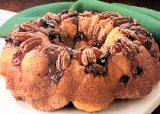Catholic Recipe: Twelfth Night Cake I

In some lands long ago, children set out to meet the three Kings with cakes and figs, and hay for the camels; in our day in some countries they still take their gifts to the church and lay them before the altar rail.
One charming story goes like this: When Mary heard the tramping feet of the camels, she picked her baby up and held him close, fearing that someone had come to take him from her. And so the Wise Men found them exactly as they had been foretold. When they went home again, the story continues, they resigned their high offices and estates and went forth to teach the gospel of the Prince of Peace; and years afterward Saint Thomas found them in India, baptized them and ordained them priests. Later they were martyred, and the Empress Helena is said to have found their bones and enshrined them in the Cathedral of Saint Sophia in Constantinople. During the crusades these relics were taken to Milan and later to Cologne where today they are to be found in the cathedral of that city in a chest of gold encrusted with jewels.
The article of food which comes first to mind for this feast is the famous Twelfth Day cake, baked and eaten in many lands. In France the Galette des Rois is cut carefully so that there will be one more piece than there are guests at the table. This, called la part de Dieu, goes to the first poor person who comes to the door. In Greece this is a double feast day for it is also that of Saint Basil, and the first piece of cake is cut for Christ, the next for Our Lady, and the third for Saint Basil.
When the cake is not divided according to purely religious custom, it is often considered a cake of luck. A bean is hidden in the cake, among other fortune-telling trinkets, and whoever finds this is crowned king or queen of the feast. France, in fact, has a proverb which comes directly from this finding of the lucky bean: Il a trouvé la fève au gâteau.
On the eve of the feast in Austrian homes, a blessing is invoked on the house and on each room individually. One of the family, carrying a shovel filled with coals and incense, goes from room to room followed by all the rest. When every room has been blessed, the household marches to the barn to bless the home of the animals too. And on that night the Christmas tree is lighted for the last time.
At Drury Lane Theatre in London a custom prevailed called "cutting the Baddeley Cake." A comedian of that name left the provision in his will that on each Twelfth Night the performers at the theater be served cake and wine from the interest of a fund he bequeathed for that purpose. So each year the cake was cut with great ceremony on the stage. And it is also from England that we have the best recipe for a Twelfth Day Cake.
Traditionally Lamb's Wool was always served with Twelfth Night Cake.
DIRECTIONS
Cream the butter with the sugar. Add the eggs one at a time and beat after each addition. Add the milk and beat all thoroughly. Mix a little of the flour with the various raisins and peels. Sift the flour with the spices and fold into the mixture. Finally add the fruits and almonds. Bake in a pan lined with waxed paper for two hours in a slow oven at 250° F. Formerly this cake was baked two or three months before it was to be used, then it was covered with almond paste and a thin white icing.
Recipe Source: Feast Day Cookbook by Katherine Burton and Helmut Ripperger, David McKay Company, Inc., New York, 1951





